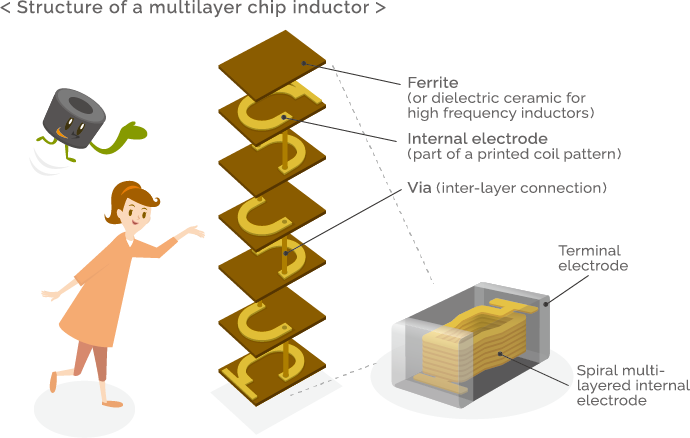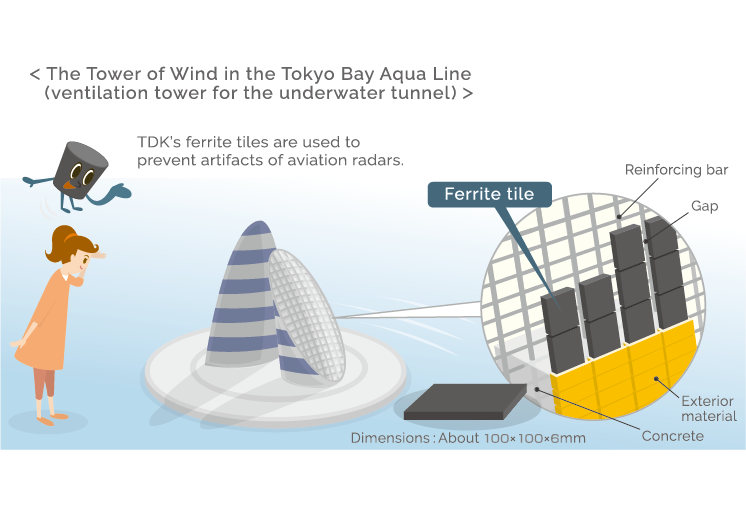Ferrite World
Vol. 9 DC-DC converter and power ferrite

Properties of power ferrite used in power supply devices
Soft magnetic materials such as ferrite are, so to speak, sleeping magnets, as they awake their magnetic properties and become magnetized when an external magnetic field is applied. The level of this awakening ability is called the initial magnetic permeability. In a hysteresis curve (B-H curve), which is a graph of the magnetization process, the steepness of the rise of the initial magnetization curve is regarded as the initial magnetic permeability.
The ferrite cores of antenna coils, signal transmission transformers, etc. are generally used in a weak AC magnetic field. In a hysteresis curve, they are represented by the range of a minor loop in the middle of the initial magnetization curve. These ferrite cores are intended to efficiently and securely transmit input signals, so high-magnetic-permeability material is used for them.
Meanwhile, power transformers and the like use different types of ferrites suitable for them. These are called power ferrites. Since power transformers are intended to transmit electrical power, a strong AC magnetic field is applied to them. Thus, power ferrites used as transformer cores need not only to have a high level of awakening ability (high magnetic permeability), but also to be powerful and efficient; therefore, a ferrite material that has high saturation magnetic flux density and low power loss is suitable for them.
However, it is not easy to satisfy all these properties. Ferrite is a polycrystal consisting of fine ferrite crystal grains, and the boundaries between crystal grains are called grain boundaries. Ferrite has high electrical resistance as compared with metallic magnetic materials, because a small amount of additive and holes are segregated in its grain boundaries in the crystallogenic process. Eddy current loss, which is a cause of power loss, can be reduced by proactively producing grain boundary layers to increase electrical resistance. However, doing this reduces the density of crystal grains that play a role in the magnetic properties, resulting in a decrease in saturation magnetic flux density. Advanced technologies are required to ensure the high performance of power ferrite while achieving a balance among its properties: saturation magnetic flux density, magnetic permeability, and specific resistance.
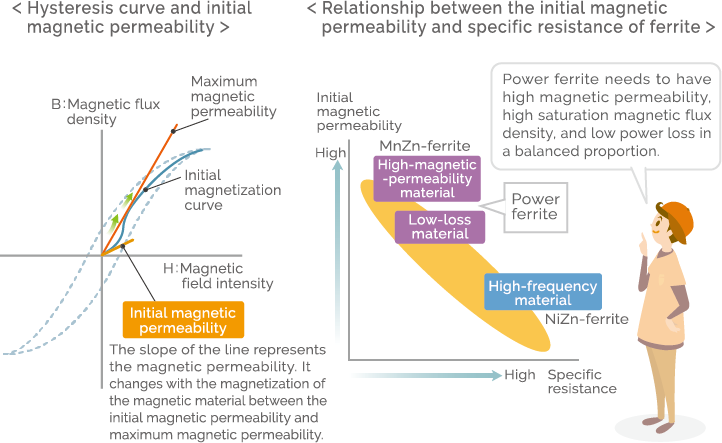
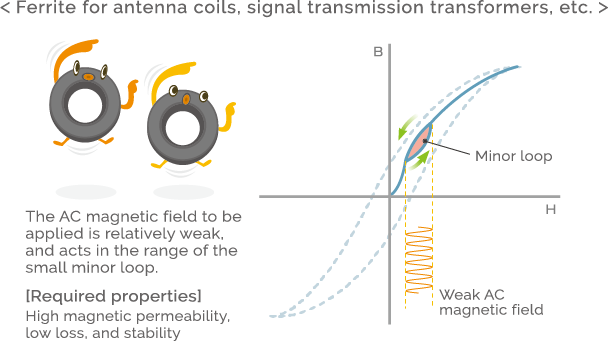
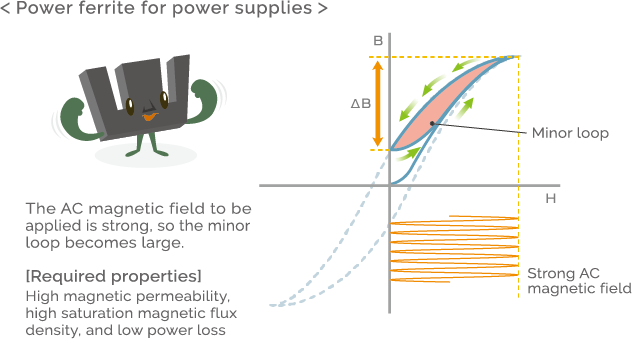
Ferrite is a material necessary for switching power supplies
Most electronic devices use ICs. In order to operate ICs without causing errors, it is necessary to supply stable-voltage direct current. This is called DC-stabilized power supply. A direct current obtained simply by rectifying commercial alternating current still contains voltage fluctuations and has low stability, and also, the voltage of batteries that drive electronic devices gradually decreases. Therefore, DC-stabilized power supply is needed.
DC-stabilized power supplies are roughly classified into linear systems (series systems) and switching systems. Those called dropper regulators are linear DC-stabilized power supplies. Their principle is very simple; a semiconductor device such as a constant voltage diode or three-terminal regulator IC is used to cut out voltage fluctuations to smooth the voltage. However, despite the simple principle, they are inefficient because the cut-out electrical power is wastefully discarded as heat.
Thus, switching DC-DC converters are widely used as high-efficiency DC-stabilized power supplies. A DC-DC converter uses a switching circuit to convert an unstable direct current obtained simply by rectifying alternating current, or the direct current of a battery into pulse currents and then sends the pulse currents to a transformer to reproduce a direct current by putting them together on the secondary side. In this process, pulse widths are adjusted by a control circuit, so they become a stabilized constant-voltage direct current when put together.
For example, when wood boards are manufactured from a log, it is impossible to make boards with a width exceeding the diameter of the log, which also produces waste materials. If this is likened to a linear system, then a switching system is like composite wood. Wood boards with ideal width can be made by cutting a log into numerous thin rods and putting these together. Also, waste materials are not produced with high efficiency achieved.
In a switching system, a direct current is converted into pulse currents because if it remains in the form of a direct current, the voltage cannot be stepped up or down (a pulse current is a sort of an alternating current, and therefore can be converted by a transformer). Switching systems have high efficiency and can also make transformer cores smaller at higher switching frequencies. Thus, switching power supplies use a high frequency of several tens of kilohertz to 1 MHz or higher. However, metal materials such as silicon steel plates cannot be used at such a high frequency. This is because heat generation loss due to eddy current loss becomes large. Meanwhile, ferrite has a million or more times higher electrical resistance than iron, so it causes less eddy current and is used as a material necessary for high-frequency transformers for DC-DC converters.
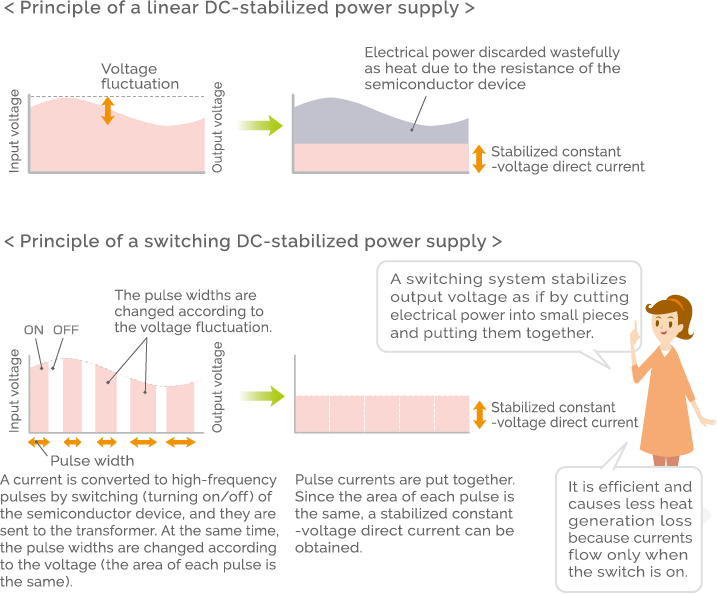
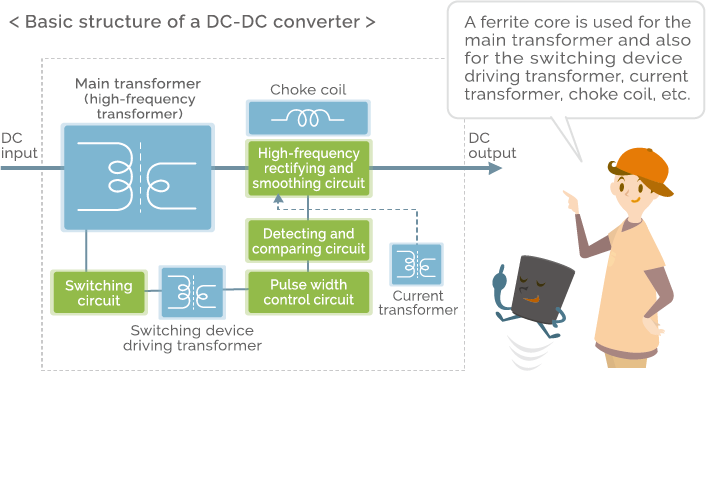
Improvements in the size, weight, and efficiency of HEV DC-DC converters are promoted
The properties of ferrites are not uniform, and the core loss of a transformer, etc. varies depending on the temperature. Therefore, in order to save energy, DC-DC converters for electronic devices use a power ferrite material that minimizes core loss in the operating temperature range (generally about 60 to 100°C). However, this does not apply to automotive electronic devices, particularly HEV (hybrid electric vehicle) DC-DC converters.
A HEV’s motor drive is powered by the electricity stored in the main battery. The main battery has a high voltage of 200 to 300 V, which needs to be converted into a lower voltage (e.g., 14 V) to operate in-car electronic devices such as a car navigation system. This is done by a HEV DC-DC converter.
The efficiency of a DC-DC converter is greatly affected by the core loss-temperature characteristics of the transformer core. General power ferrites show a V-shaped core loss-temperature curve in which the core loss becomes minimal in a certain temperature range. However, unlike indoor-use electronic devices, HEV DC-DC converters need a ferrite material that has low loss in a wide temperature range because cars run in various temperature environments from fierce cold to extreme heat.
TDK’s power ferrite PC95 material offers the industry’s top-level low-loss properties while maintaining high saturation magnetic flux density, over the wide temperature range from -40 to +120°C. This is thanks to the advanced uniformity of starting materials (iron oxide and other raw material powder from which ferrite is generated by sintering), the high-accuracy control of additive in minute amounts, the reviewing of the sintering process, etc. It is a revolutionary material that reduces core loss in the main transformer of a HEV DC-DC converter by 30 to 40%, as compared with conventional materials.
TDK started producing HEV DC-DC converters in 1995. Design of DC-DC converters is a struggle against heat. TDK has been leading in reducing the size and weight of HEV DC-DC converters and improving their efficiency, thanks to heat dissipation design that exploits heat simulation technologies and others, in addition to accumulated ferrite and transformer technologies. TDK’s DC-DC converters, which use the PC95 material for transformer cores, are employed in HEVs in Japan and foreign countries and are significantly contributing to energy-saving driving.
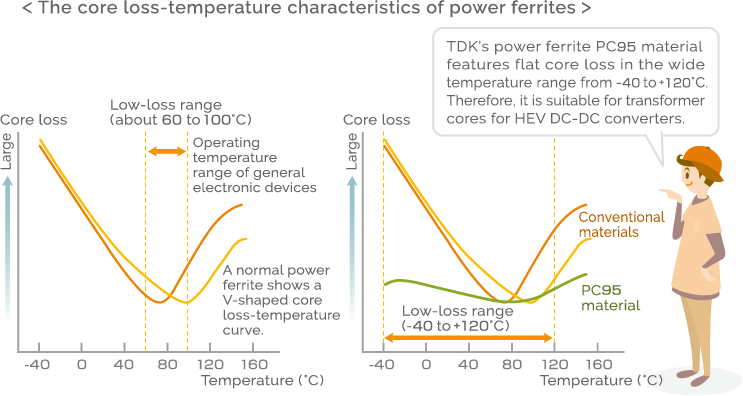
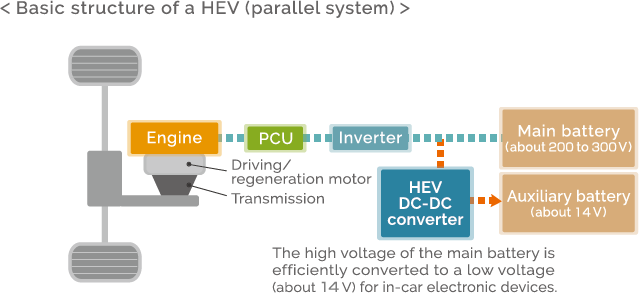
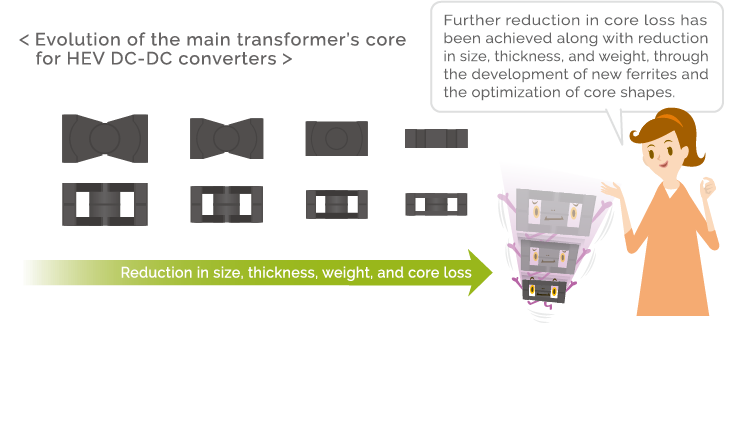
TDK is a comprehensive electronic components manufacturer leading the world in magnetic technology



